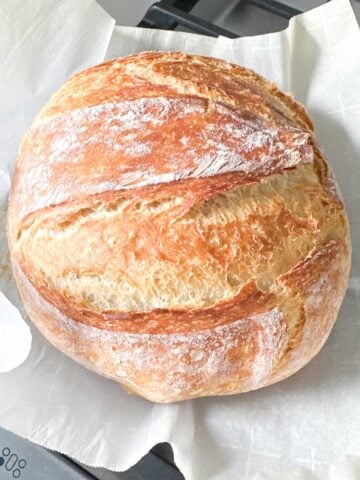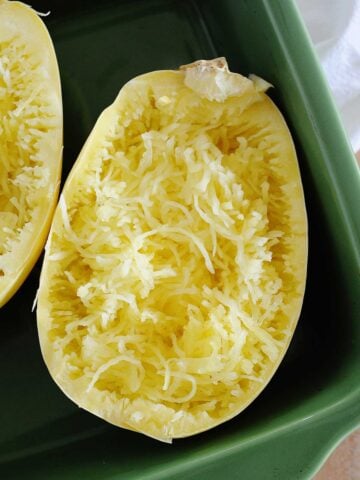Want to know how to use a meat thermometer so your chicken, steak, pork -and even seafood- come out perfect every time?
You’re in the right place. No matter the protein you want to cook, I’m sharing all the necessary details so you can step into the kitchen and cook that meal confidently.

If this is your first time cooking with a meat thermometer, you’ll find all of the following information helpful.
But, if this isn’t your first time (or you have a steak sizzling in the pan), here’s a table of contents to help you navigate your way to the most crucial questions. Now, let’s get rolling.
What Is a Meat Thermometer?
A meat thermometer is a small device composed of a thermometer attached to a probe with a pointed end. The tapered edge makes it easy to insert into the meat and record the internal temperature.

Types of Meat Thermometers
There are two types of meat thermometers: analog and digital. Both are used to record the temperature of all meat, fish, and poultry cuts. A digital thermometer displays the degree in bold numbers, while analog thermometers have a needle that moves based on the temperature.
Here are a few more details on both options, with links provided to the ones I’ve tested and found to be true:
Digital Meat Thermometer
This one instantly catches the internal temperature and displays the degree in either Celcius or Fahrenheit. I like using the Deiss Digital Meat Thermometer, which is water-proof, making it easy to clean.
Analog Meat Thermometer
This option works like a traditional thermometer in which a red arrow points to the degrees listed in both Celcius and Fahrenheit. It’s incredibly accurate, and the display looks similar to a hand watch.
How to Use a Meat Thermometer
Now, let’s get to the meat of the matter- literally!
How to Use Meat Thermometer Correctly
- Remove
To use a thermometer, you will want to remove the cooking meat from the heat source (oven, stove, grill, etc.).

- Insert
Insert the thermometer into the thickest part of the cut, avoiding fat or skin, and leave it in until the temperature reading levels out.
You can turn off the heat or continue cooking based on the internal temperature. Reference the chart below to see if the meat is properly cooked.
| Protein | Internal Temp |
|---|---|
| Beef: steak & roast | 145F / 63C |
| Ground beef & sausage | 160F / 71C |
| Pork: loin & chops | 145F / 63C |
| Ground pork & sausage | 160F / 71C |
| Poultry: chicken & turkey (white meat) | 165F / 73C |
| Poultry: chicken & turkey (dark meat) | 175F / 79C |
| Ground poultry & sausage | 165F / 73C |
| Fish: whole fish or fillets | 145F / 63C |
Using a Meat Thermometer on Bone-In Chicken and Steak
To get the most accurate temperature of bone-in chicken or steak, you’ll want to insert the thermometer at the thickest part away from the bone and fat.
These two substances take longer to heat up than the actual protein and can cause you to miscalculate and overcook the meat.
Getting an Accurate Reading from Your Meat Thermometer
Before you start cooking, look over these simple tips, so your recipe turns out perfect.
Remove meat from the heat source
For an accurate reading, you’ll want to record the temperature away from the oven, stove, or grill, which can significantly increase the thermometer reading.
Use a fork
When grabbing the temperature from skin-on cuts of chicken like my Baked Split Chicken Breasts, use a fork to gently lift the skin and insert the thermometer directly into the chicken.
If you cook chicken quite often, it can be a little trickier than beef and fish. Use a thermometer in addition to these helpful tips on how to know when chicken is done.
Cooking Fish
Checking the internal temperature of fish is no different from steak or chicken: find the thickest part and insert the thermometer probe.

How to Clean Your Meat Thermometer
Once you’ve used the meat thermometer, don’t forget to wash it with warm soapy water, even digital ones, which are often water-proof. If you aren’t certain, check the package’s label or online store.
When to Use a Meat Thermometer
The best time to use a meat thermometer is when the outside of the meat begins to develop a browned crust, after flipping, or there are 5 minutes of cooking time left according to the recipe’s directions.
You don’t want to wait for the recipe’s full cook time; a couple of minutes before is best.

Do You Need to Calibrate Your Thermometer
When directed, all thermometers (digital and analog) should be calibrated before use; it ensures accuracy and is easy to do with the boiling point method, which is when you fill a large pot with water and bring it to a boil, between 190 – 212F. Place the thermometer probe into the boiling water and wait until it reaches a steady temperature.
If your analog thermometer reads too high or low, you may need to adjust it. If you’re using a digital thermometer, many of them have a reset button, so if it’s misreading, you can fix it using the manufacturer’s instructions.






Rachael says
When inserting the thermometer into the largest area of the protein, does the thermometer need to be inserted halfway down the largest area or just at the top of the protein is fine? I always wondered this. :/
Thank you!
Laura Fuentes says
Great Q! “Where” depends on the protein. The general rule is at the thickest part, at least halfway through the protein.